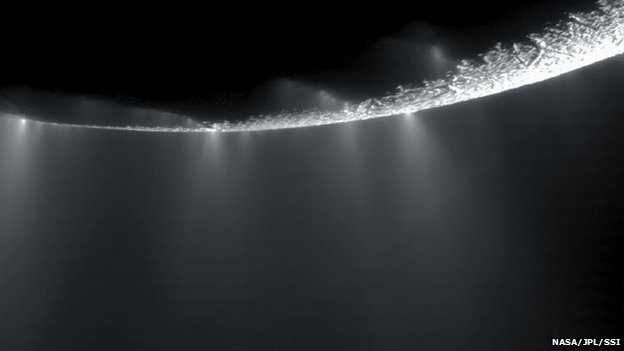Deepest ocean in the solar system
Interview with
Chris - To outer space now, and Enceladus, one of Saturn's 62 moons. This one is important because it gives rise to what some people have dubbed "the biggest geyser in the galaxy". Not a big bloke. It's actually a periodic plume of salty water which jets thousands of kilometres out into space and even contributes to Saturn's ring system. Now, scientists think that they have pinpointed where this water is coming from. They think they've got evidence for giant internal ocean, which is deep within the moon. Madhu Sudhan is a lecturer at the institute of astronomy in Cambridge. And he's with us to tell us a bit more about it.
Madhu - This is actually a very exciting discovery. The Cassini Mission which has been close to Saturn for more than a decade now has made several flybys across the moon Enceladus. As early as 2005 which was just the year after it's going into Saturn's orbit, it found these plumes coming out of the southern pole of the moon Enceladus. So, there were theories saying that there should be an ocean beneath its icy crust which should be the source of this water vapor and salt that are coming out of these vents in the southern side
 |
| Plumes of water ice are ejected kilometres above the surface of Saturn's satellite Enceladus |
Chris - What's powering that phenomenon though because to jet water thousands of kilometres into space takes a lot of energy? So, where's that energy coming from?
Madhu - Recently, in the past 4 or so years, there have been recent studies suggesting that it's the tides caused by the planet Saturn itself and another moon in the system. The tidal energy is causing these vents to squeeze and open up as the moon is going around the planet.
Chris - So, it gets a gravitational massage - for want of a better phrase - by Saturn and this causes friction to heat up the water. So, the water must be coming from somewhere. Is this just ice melting or do we think there actually is a big reservoir of water inside Enceladus?
Madhu - So, that's where the latest study comes in, which basically points to the possibility that there's a big ocean in the southern side of the moon that lies 30 to 40 kilometres beneath the icy crust. The water layer itself is estimated to be about 10 kilometres in thickness.
Chris - Gosh! That's a pretty deep ocean. I mean, that's on par with the deepest parts of Earth's oceans, isn't it?
Madhu - Yeah, exactly.
Chris - In a moon which is only about 500 kilometres across. It's so tiny, isn't it?
Madhu - Yeah, in diameter. It's very small.
Chris - How did they use Cassini to work out what's going on inside the moon to the depth of 30 or 40 kilometres where you can't see?
Madhu - Yes. So, the principle is actually very simple. They used Doppler effect. Basically, they were tracking the velocities of this spacecraft as it is flying by the moon. What happens is that the gravity caused by the moon itself alters the motion of this spacecraft across close to it. Now, just due to the force of gravity, there'll be some subtle variations in the velocities of the spacecraft. The ground stations can track these signals from Cassini at precision below 0.1 mm per second very precise
 |
| Plumes of water ice are ejected kilometres above the surface of Saturn's tiny satellite Enceladus |
Chris - Good grief! This probe is how far away from Earth?
Madhu - This is about 1.4 billion kilometres away.
Chris - Extraordinary, isn't it? So basically, by looking at how the gravitational field of the moon influences the flight of the spacecraft, you can work out what must be inside the moon, but just how much mass must be there?
Madhu - The mass and the structure of the mass. So, a camera onboard the spacecraft itself has found a depression on the surface of the moon itself. So based on that, you can estimate what the gravity field should be. But they found that based on this Doppler Effect, they found there should be an additional source of gravity beyond what is inferred just from photographs basically.
Chris - So, they don't know it's water, but putting all of the data together, the gravitational measurements, the fact there's water issuing periodically from these vents in the south pole, it only really fits with water.
Madhu - It's not necessarily the vents itself. It's that, you need an extra source of gravity to explain the Doppler measurements and that has to come from a higher density than ice itself. Water fits the bill almost exactly.
Chris - If you have got a source of water in this place and it's clearly warm water if it's expanding and blowing out into space like this, could that be potentially a home for something to live?
Madhu - So, water is a very good candidate for astrobiology. So yes, that's why this moon is very interesting. So, the answer is yes.
Chris - A home from home perhaps. Thank you very much, Madhu Sudhan from the Institute of Astronomy in Cambridge. Kat...
- Previous Smoking may make your children obese
- Next Regenerating Nerves









Comments
Add a comment